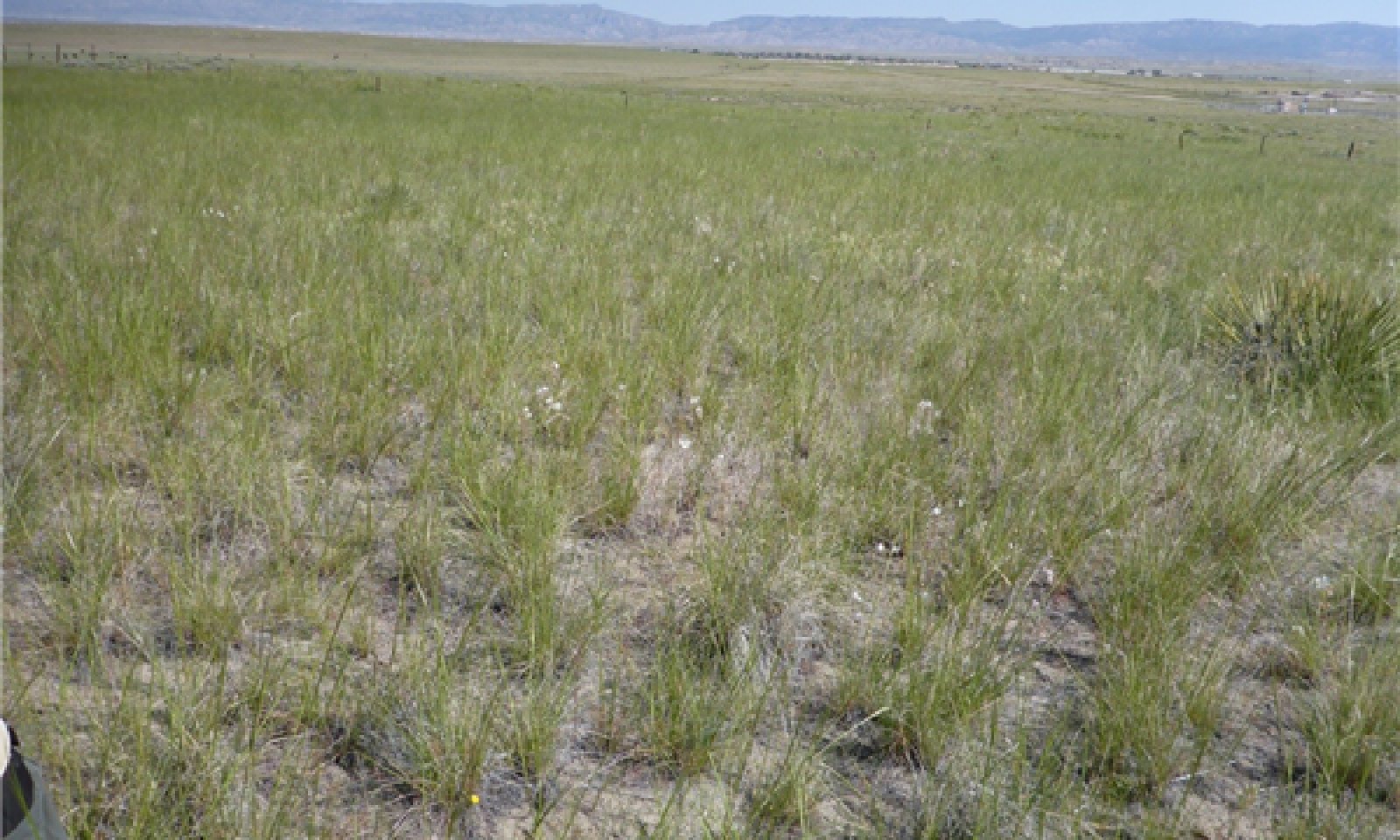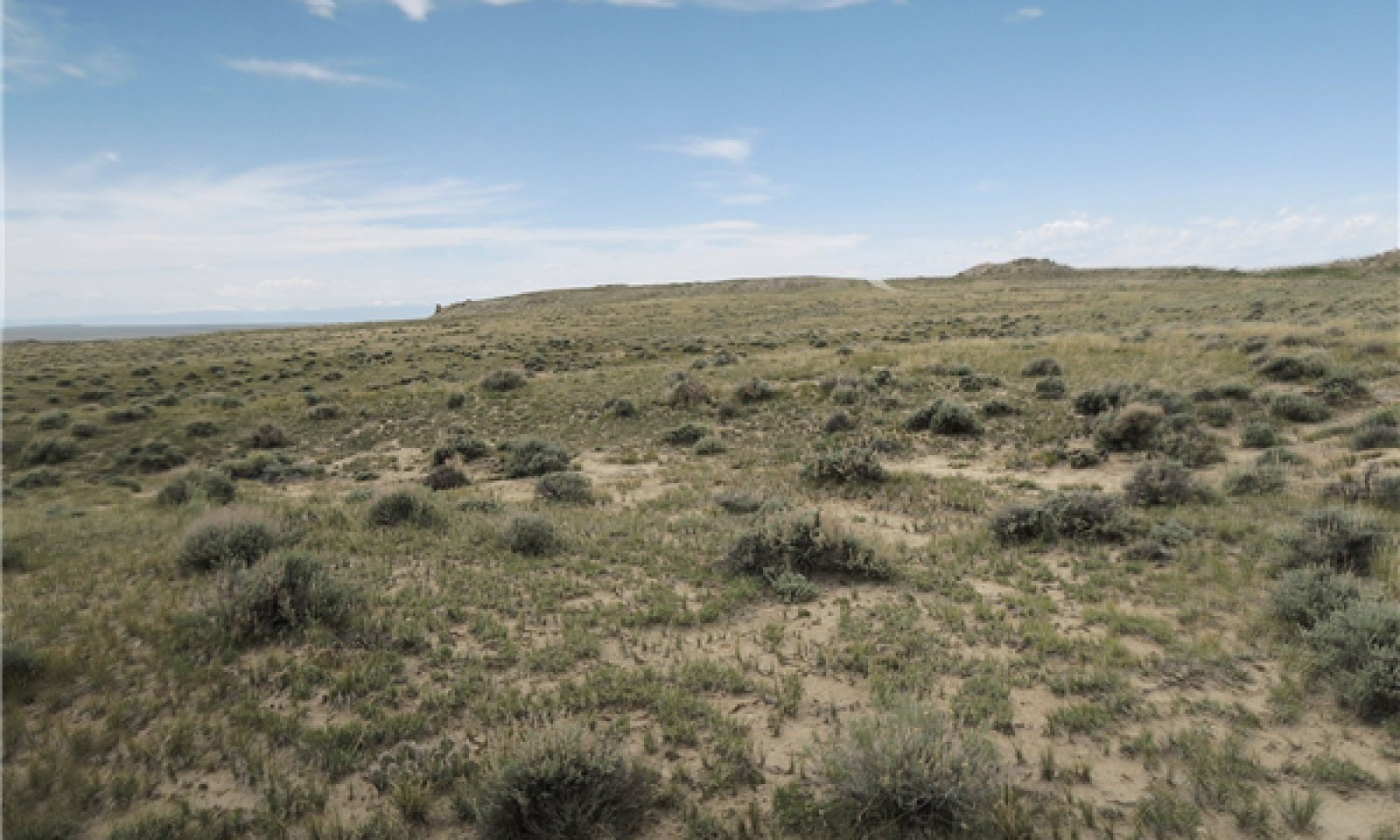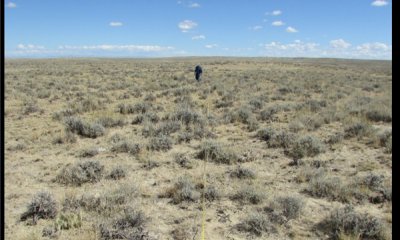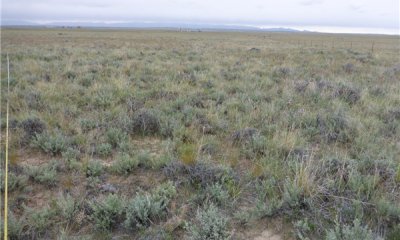
Sandy (Sy) Wind River Basin Core
Scenario model
Current ecosystem state
Select a state
Management practices/drivers
Select a transition or restoration pathway
- Transition T 1-2 More details
- Transition T 1-3 More details
- Restoration pathway R 2-1 More details
- Transition T 2-3 More details
- Transition T 2-4 More details
- Transition T 2-5 More details
- Transition T 3-4 More details
- Transition T 4-5 More details
- Restoration pathway R 5-6 More details
- Transition T 6-5 More details
-
No transition or restoration pathway between the selected states has been described
Target ecosystem state
Select a state
State 1
Bunchgrass/Sagebrush



Description
Bunchgrass/Sagebrush State (State 1 - Reference) is characterized by the key species including: 10% or less composition by cover of Wyoming big sagebrush, with Needleandthread (30-50% composition), Indian ricegrass, and isolated areas of western wheatgrass. Minor components to the overall composition are Prairie junegrass, Bottlebrush squirreltail, Prairie sandreed, sand dropseed, threeawns, blue grama, and threadleaf sedge.
Submodel
Description
Wyoming big sagebrush creates a niche for most herbaceous understory to persist and maintain some vigor in difficult conditions by utilizing the moisture and shade provided by the canopy as well as protection from grazing. Persistence of drought and/or frequent over use by livestock and/or wildlife leads to a decline of the herbaceous species, creating the Wyoming Big Sagebrush and Bare Ground state. This state can be exacerbated by insects and other human disturbances. The total woody canopy cover does not necessarily always increase with this community, but the percent composition by cover and production is swayed by the decrease of herbaceous vegetation and the relative stability of production by the woody species, creating the appearance of increased canopy by sagebrush.
Risk of wildfire within this state is minimal due to the lack of fine fuels within the understory, but the canopy of the woody vegetation can easily carry a fire under certain weather conditions. The loose or coarser texture of these soils allows for increased wind scour and drifting/mounding to occur with more open ground between canopy “patches”, that further hinders fire movement. Depending on the prescription of use, trailing and other erosional patterns are highly visible in this state.
Protection from wildfire and use, on a long-term perspective, can aid in the transition of a reference community (1.1 or 1.2) to this state as sagebrush becomes dense and decadent reducing the ability for the herbaceous component to maintain vigor; leading to high amounts of bare ground and sagebrush cover. As the herbaceous cover declines and the site continues to weaken, the sagebrush cover is susceptible to attack by insects, disease, and general old age that can remove it from the system leaving it at risk of invasion or transition to a more degraded state. There is a high level of variability of species in this state (State 2), that will shift with precipitation patterns or as a response to past management. Only one well defined community will be provided, with discussion of transitions or variances from this community.
The overall droughty nature of coarse textured soils exacerbates the impact of droughty conditions and reduces the resilience and resistance of this site to further shift during extended dry periods. Yucca’s presence on this site is not frequent, but when it does occur, it can easily become prominent, specifically for winter grazing allotments. Yucca’s growth habits produce a more pronounced pedestalling and drift/scour pattern on the landscape than seen with sagebrush.
Submodel
State 3
Sod-formers



Description
The dominant sod-forming grasses/grass-likes that currently exists within this LRU are blue grama and threadleaf sedge. Both are species that persist as a component of the perennial vegetation naturally (in reference communities) within this ecological site. The general tendency is for these species to increase with prolonged drought or under grazing pressure, becoming dominant. Together as the dominant species, they alter the hydrology of the site by increasing the surface runoff from the dense shallow root system that inhibits the movement of water through or will direct surface flow around the edge of the “clump”, concentrating flow into channel like patterns, creating a drier environment for native grass species and forbs to persist.
Submodel
Description
Cheatgrass or downy brome (Bromus tectorum) has quickly become the greatest threat to much of the rangelands across Wyoming. Multiple growth cycles throughout a year leaves a thick litter (duff) layer and builds a significant seedbank. Cheatgrass’s ability to persist through the winter under a blanket of snow and sprout early gives it the advantage. Shifts in climatic patterns, changes in management, and exposure to human activity are a few of the explanations for the current flush and rapid expansion across the western United States.
Although cheatgrass is the most prevalent large scale threat for rangeland managers, a variety of knapweeds (spotted, Russian, etc.), in combination with other aggressive invaders such as whitetop (hoary cress), black henbane, field bindweed, and leafy spurge are increasing in density and frequency, producing their own set of challenging management issues. As more species are found or as other species become more prevalent on a large scale, the community dynamics in this state will shift in response to the concerns of the identified species.
This state is characterized by the presence (not dominance) of invasive/non-native species. Extended periods of drought alone or in combination with over utilization, insect damage or wildfire has weakened the native composition of the community opening the canopy for invasion. The competitive nature of annuals and other invasive species, creates a complex environment that inhibits control, and makes it implausible to attain complete eradication once an invasive species has established on the landscape.
Submodel
Description
The transition of an Invaded/Sagebrush community into the Invaded state, is typically a result of wildfire, or other events that remove the sagebrush from the site and allows a readily available seed bank or seed source of the undesirable species to flourish. The most common within the Wind River Basin and surrounding regions is cheatgrass.
There are other threats present, such as knapweeds and whitetop, which can develop into near monoculture stands. The loss of diversity, changes to the potential of a site due to allelopathy or other deterrent characteristics of invasive species, and risks or land use capabilities associated with the various invasive species creates a hostile environment for both native species and grazers. The resilience and resistance of the invaders create a management road block that is usually financially driven. Many times, once an invasion reaches this point, many land managers have no choice but to utilize what they have rather than to try to treat or improve the site, specifically in relation to cheatgrass control.
Submodel
Description
The arid nature of this region has played a major role in the development and transitions in land use over time. Landscapes accessible by irrigation water and equipment were farmed and many were later abandoned and left to return to rangeland. Other landscapes were treated with a variety of prescriptions to manage or eradicate sagebrush. Tillage of the soil, change in hydrology caused by the loss of vegetative structure, constant climatic fluctuations, and advancements in seed sources have created this altered state.
Once a soil has been disturbed, whether it was mechanical, cultural, or natural the change in soil structure, hydrologic function, and possibly stability prevent a site from supporting the native vegetation or responding to management the same as an undisturbed site. Reclamation or restoration of an area will not replace the original function and factors that made the original location respond as it did. So these "altered" lands may, after significant inputs and time, look similar to the Reference communities (1.1 or 1.2), but they will not be able to respond/function as the Reference community will.
The disturbed or degraded state could be drafted as a stand-alone box within the state and transition model diagram. No matter what state a location is classified, once the site has experienced an event that has altered the soil properties (erosional, depositional, hydrological or chemical), the site potential is altered. To consider this as an alternate ecological site would not be unreasonable. In some cases (site by site consideration), a re-correlation of a location may be the best solution. But in many cases, the soils have not been altered out of the current site characteristics, but the potential has shifted enough that it is no longer truly comparable to the Reference state (State 1).
The species selection, extent or occurrence of tillage, and the resulting loss of structure, degradation of the biota within the soil, drying of the soil, changing of the infiltration and water holding capacity of the soil, and change in permeability are all factors that affect a planted site. The time required for structure and biota to rebuild, altered hydrology and chemistry, as well as plant variety establishment are highly variable in succession of the site depending on the climatic conditions following the event. The initial flush of vegetation is kochia and Russian thistle and mustards. Although they provide organic material, nutrient flow and erosional protection, they lack the structure and root system to fully stabilize the site. With time, the site may become similar in composition to reference, but the integrity of the soil is altered, changing potential of the site. So a dynamic state was captured to detail the altered communities that exist on the landscape.
Submodel
Mechanism
Frequent and Severe Grazing (Year-long) or Drought with the absence of Brush Management or Wildfire - Frequent or high intensity herbivory weakens the ability for the grasses to persist, especially during prolonged drought. With the weakened herbaceous cover and with prevention or lack of fire, the composition will shift to predominantly Wyoming big sagebrush, and with time sagebrush will increase preventing the recovery without intervention. The conversion to a Wyoming Big Sagebrush/Bare Ground plant community is a response to extended periods of stress, both climate and/or human induced. Intensive grazing with minimal to no recovery period begins to transition the community. With added climatic stress, species diversity and productivity is lost, and the community crosses into the Sagebrush/Bare ground State. The illusion of crossing the threshold to State 2 is captured with fluctuating precipitation patterns affecting production of prominent plants within this system. The loss of species diversity and increased bare ground with lack of litter are the indicators that a true transition has occurred. It is important to recognize that woody cover is a factor of the number of plants as well as canopy cover. In some instances, the number of actual sagebrush plants may not increase to cause this shift, but the change in composition or vigor of the wood canopy, as well as the loss of herbaceous canopy, creates the illusion of increased number of plants when it is more the size and age that is more likely to shift.
Mechanism
Frequent Grazing (Yearlong), Brush Management or Fire with Drought – Severe and frequent grazing reduces vigor and presence of key species. As needleandthread and Indian ricegrass continue to decline, shorter statured grasses become dominant. Animal disturbance (hoof impact) caused with long duration, high intensity herbivory reduces the bunchgrass component by allowing repeated defoliation of the desirable species, reducing recovery potential and ground cover for insulation and snow catch, as well as physical damage to the crown and growth points of the plants; weakening and over time removing select species. The open canopy and hoof impact encourages species that are tolerant to trampling and short bursts of spring and summer precipitation, these species are generally mat or sod-forming species such as blue grama and threadleaf sedge. Prolonged drought stresses the plants, and opens the canopy for these two plants to fill in the interspaces. The shallow, dense root mats will continue to spread over time. The added removal of sagebrush with animal impacts, fire or brush management may open the canopy more and aid in establishing this sod community. When the sagebrush component of this community has been degraded or removed, by drought or heavy use, the transition has a high probability of occurrence on the landscape. Season of use and intensity of grazing (time and timing) is a trigger that can reduce the risk of transitioning, or if done improperly can force the transition to occur rapidly. The added or increase in blue grama adds an element of mid-summer growth that extends the active growing season grazing window. But this window, if lacking adequate moisture, does not provide sufficient growth to prevent use or overuse of the cool-season species and could further degrade the community.
Mechanism
Prescribed Grazing with Brush Management or Wildfire - Treatment to thin or rejuvenate the sagebrush canopy to allow the native vegetation to respond to improved moisture and sunlight followed by prescribed grazing to prevent overuse of the exposed grasses will help this community recover. Treatment will vary depending on the existing composition of grasses remaining and the potential threats to the location. Removal or thinning of the sagebrush within this community will help to reduce competition, encouraging grasses and forb recovery if the disturbance or over-use (recreational or grazing pressure) is reduced. Drought may prolong the time required for recovery. Mowing or mulching sagebrush trials have shown a strong response by grasses with little to no recovery time post-treatment. The resulting community with these treatments is driven by the dominant species within the community pre-treatment or climatic and treatment conditions during and following fire may sway the community. It is crucial to investigate the immediate and surrounding area around treatment sites to ensure no invasive species (cheatgrass) are present before treatment type is decided and then applied.
Relevant conservation practices
| Practice | External resources |
|---|---|
|
Brush Management |
|
|
Prescribed Burning |
|
|
Critical Area Planting |
|
|
Fence |
|
|
Livestock Pipeline |
|
|
Grazing Land Mechanical Treatment |
|
|
Range Planting |
|
|
Heavy Use Area Protection |
|
|
Spring Development |
|
|
Integrated Pest Management (IPM) |
|
|
Watering Facility |
|
|
Native Plant Community Restoration and Management |
|
|
Prescribed Grazing |
|
|
Invasive Plant Species Control |
Mechanism
Drought, Disease or Insect Damage, Over-use, or Fire - Sod-forming species such as blue grama and threadleaf sedge are able to tolerate high levels of use and will maintain as other native species decline. Hoof action or compaction inhibits more desirable native species, allowing the sod-formers to become dominant on the landscape. This decline creates a sagebrush/sod community that is resistant to change with management. Impacts to sagebrush by disease or insect damage, as well as drought or herbivory, will shift this to the secondary community phase with cactus as a subdominant cover with blue grama.
Mechanism
Fire (wild), Frequent or Severe Grazing, Drought with Insect Damage/Brush Management – Throughout most of this LRU there is a seed source present for cheatgrass, knapweed, and other invasive species. Stress to the native community from fire, drought, disease/insect damage to sagebrush, or ground/soil disturbance including impacts by grazing large herbivores or recreational uses; opens the canopy and breaks the surface of the soil, creating a niche for invasion by undesirable plants/invasive weeds. One or two isolated plants of an invasive species, if caught, can be treated and a full infestation avoided; however, when unseen or ignored, the population soon grows exponentially as further stress or disturbance occurs. In some cases once the invasive species are established, they can create their own habitat; this reduces the competitive ability of native species. The open canopy of the Sagebrush/Bare Ground State is vulnerable to invasive species without further influence. With continued over-use, drought, or insect damage/disease, the invasive species will establish and quickly dominate a location. The threshold species in this system is Wyoming big sagebrush, which protects the remnants of the perennial native grasses, allowing them to persist on the landscape.
Mechanism
Brush Management, Fire, or Other Disturbance with Seed Sources - Removal of the sagebrush by mechanical, chemical or fire with a seed source available for weedy species, will lead to this community. Even if remnant populations of the native perennial desired species are present, disturbance allows the weedy species to out compete native species. When the sagebrush canopy has been removed, the soils are droughty and prone to wind and sun, affecting the ability for new seedlings to establish. This limits the ability of this community to recover, even with weed control plans in place. Catastrophic disturbances that remove all shrub cover and open the site to complete invasion by weedy species, most commonly cheatgrass, require significant time and resources to restore to a native community.
Mechanism
Frequent and Severe Grazing, Drought, Disturbance with a seed source present - The chance of wildfire is minimal with the lack of fine fuels and reduced sagebrush canopy leading to the assumption this community/state is safe from invasion. The increased interspatial pattern of these communities leaves exposed soil that is vulnerable to invasion by undesirable species. Increased pressure from over use and drought work to weaken the sod or mat-like community of low stature grasses, exposing soil further to annuals and other invaders, such as cheatgrass and knapweeds. If seed source is available, ground disturbance by herbivores or man-induced, allows invasive species to find a way into the community. Once established in the community, it is extremely difficult to manage and may not be feasible to completely remove them from the community. Once the invasive species have become prevalent on the landscape (>5% composition), the community crosses the threshold into the Invaded/Sagebrush State (State 4).
Mechanism
Fire, Drought, Ground Disturbance, Over Use - Once a community has been compromised by a notable composition of an invasive species, stress or ground disturbance of any means can cause the invasive species to take over and dominate the site. Wildfire, extreme drought and the accompanying disease and insect damage, as well as frequent and intense use by large herbivores are the impacts most commonly seen to insight a weed infestation. Any action that reduces or damages the existing sagebrush canopy exposing the sensitive native grass population will start the transition. Drought, further disturbance or improperly timed grazing (grazing when the desired species are in the early boot growth stage or beginning to flower), will remove the competition and finish the transition.
Mechanism
Integrated Pest Management, with Seeding - Integrated pest management plan and intense weed control after and possibly before seedbed preparation will be necessary to overcome a severe weed infestation. Working the soil and preparing a seedbed at a location and using either improved varieties, native seed, or in some cases an introduced species suited for the management use intended may be the only way to overcome some invasive species. Success of re-establishing a native or desired plant community on a large scale is not documented. Small scale attempts are rated to be low and highly variable for the rate of control of most species. It is a consensus that the site in theory could be brought to a community that looks similar to an at-risk community within the reference state, but that it is not possible to reach the reference community condition once annuals have established on a site. This is due to the need to work the soil or to do seedbed preparation to plant the native species which reduces soil stability by breaking down soil structure, and alters the hydrologic cycle by changing the infiltration and percolation rates of the soil. The alteration of the soils, the change in the plant community and the risk of re-invasion of the site will never allow it to react the same to management and environmental changes the same as a truly native community and so remains in a reclaimed state.
Relevant conservation practices
| Practice | External resources |
|---|---|
|
Brush Management |
|
|
Prescribed Burning |
|
|
Critical Area Planting |
|
|
Fence |
|
|
Livestock Pipeline |
|
|
Grazing Land Mechanical Treatment |
|
|
Range Planting |
|
|
Heavy Use Area Protection |
|
|
Spring Development |
|
|
Integrated Pest Management (IPM) |
|
|
Watering Facility |
|
|
Upland Wildlife Habitat Management |
|
|
Early Successional Habitat Development/Management |
|
|
Native Plant Community Restoration and Management |
|
|
Prescribed Grazing |
|
|
Invasive Plant Species Control |
Mechanism
No Use, Fire (wild or prescribed), Frequent or Severe Grazing, Drought with Seed Source Present – In the reclamation or restoration process, or after a land disturbance occurs, if no management is put into place to prevent a reoccurrence or a new infestation of weeds, the community will revert back or transition to an invaded state. Wildfire, prescribed burning, drought, or frequent and severe miss-use by large herbivores can be a source of the disturbance that either opens the canopy and/or introduces the species to the location. Extended periods of non-use creates a decadent community with a large proportion of dead growth persisting around the crown of the plants, reducing vigor and production. As the plants begin to die-back, the community becomes vulnerable to weed invasions. Opposite of the non-use scenario, it has been found that frequent or severe grazing, drought, or fire can open the canopy to invasion as well. This invasion triggers the transition to an invaded state.
Model keys
Briefcase
Add ecological sites and Major Land Resource Areas to your briefcase by clicking on the briefcase (![]() ) icon wherever it occurs. Drag and drop items to reorder. Cookies are used to store briefcase items between browsing sessions. Because of this, the number of items that can be added to your briefcase is limited, and briefcase items added on one device and browser cannot be accessed from another device or browser. Users who do not wish to place cookies on their devices should not use the briefcase tool. Briefcase cookies serve no other purpose than described here and are deleted whenever browsing history is cleared.
) icon wherever it occurs. Drag and drop items to reorder. Cookies are used to store briefcase items between browsing sessions. Because of this, the number of items that can be added to your briefcase is limited, and briefcase items added on one device and browser cannot be accessed from another device or browser. Users who do not wish to place cookies on their devices should not use the briefcase tool. Briefcase cookies serve no other purpose than described here and are deleted whenever browsing history is cleared.
Ecological sites
Major Land Resource Areas
The Ecosystem Dynamics Interpretive Tool is an information system framework developed by the USDA-ARS Jornada Experimental Range, USDA Natural Resources Conservation Service, and New Mexico State University.





